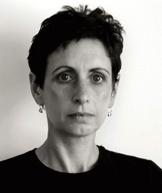Lecture: Elizabeth Kolbert

Elizabeth Kolbert. Photo courtesy of www.dartmouth.edu.
RELATED:
In June 2001, New Yorker reporter Elizabeth Kolbert jetted to Northern Greenland in a ski-equipped U.S. Air Force LC-130 plane, one of the region's few modes of transportation. While there, she slept in a tent atop the second-largest ice sheet on Earth. She traveled nearly 500 miles in a rundown truck on the isolated James W. Dalton Highway from Fairbanks, Alaska to the northern town of Deadhorse, with only a bag of Tostitos chips to keep her going. All this just to get a story. "I wanted to get to the heart of the matter," said Kolbert, who spent four years researching and writing about the global warming crisis.
On an unseasonably warm afternoon in early October, Kolbert spoke to a group of New York University journalism students and faculty about the perils of climate change. The Question & Answer session, facilitated by Pulitzer-Prize winning Los Angeles Times science writer, Robert Lee Hotz, focused on the first installment of Kolbert's three-part series for The New Yorker, "The Climate of Man," a series Hotz compared to Rachel Carson's Silent Spring (Houghton Mifflin 1962), a book that helped to launch the environmentalist movement almost half a century ago.
Kolbert discovered her passion for the subject in 2001 while on assignment for The New Yorker at the North Greenland Ice Core Project (North GRIP). North GRIP scientists revealed that average annual temperatures in Greenland had increased almost twenty degrees in just one decade. Yet "If you asked 99 of 100 people, they [wouldn't] even know what global warming was at that time," Kolbert said. As a way to explain the urgency of abrupt climate change, Kolbert chronicled the lives of the North GRIP scientists and discussed the implications of their discoveries in the January 2002 article, "Ice Memory." The piece was included in The Best American Science and Nature Writing 2003 (Houghton Mifflin), an acknowledgement of Kolbert's significant contribution to scientific reporting. Still, Kolbert is reluctant to take credit for the role she played in educating the public. "I didn't break any news," she said. "I just wanted to write something people would read."
While discussing Kolbert's achievements, Hotz noted the "geographic sweep" of her reporting, which he characterized as "street reporting carried to a remarkable extreme." Accompanied by a slideshow featuring photographs of places she's visited, Kolbert discussed some of her other travel experiences. At Greenland's research station, Swiss Camp, which is rendered largely uninhabitable by the constant motion of the ice sheet it rests on, Kolbert had to stay in a tent that was identical to the one in which Robert Scott was found dead after his ill-fated January 1912 expedition to the South Pole. Moving on to pictures of Shishmaref, an Alaskan village off the coast of the Seward Peninsula, the reporter took a second to mourn the impact of global warming. The layer of ice which once formed a boundary between the village and the violent ocean waves no longer freezes over, allowing storms to errode a 125-foot-wide strip of land, studded with homes. "That place is just being eaten away," said Kolbert, in a tone at once somber and matter-of-fact.
After retracing the steps she took to bring the issue of global warming to the fore, Kolbert discussed the challenges of science reporting. How did she turn four years of notes and tape recordings into three concise articles, one student wondered? Kolbert admitted, head hanging low, that she has no organizational system. While she did not recommend that approach to the students present, Kolbert did mention a strategy that makes her system (or lack thereof) work. "I write as I report," she said. "It's always best to write as close to having seen something as possible."
Despite her organic approach to reporting, Kolbert is methodical when it comes to taping her interviews, because The New Yorker's "laborious and rigorous" fact-checking process demands that she be able to corroborate everything she writes. After a 14-year career with The New York Times, where Kolbert said "there was very little structural editing," it took some time to accustom herself to The New Yorker's meticulous copyediting process. "With newspapers, you are the only thing standing in between the readers and the paper," she said. Magazines, on the other hand, have fact-checkers who share the burden of journalistic integrity. Despite the rigorous process, one factual error did appear in the 30,000 word “The Climate of Man” series. The wrong unit was attached to a number indicating the speed of an ice stream. "Of course, we printed a correction," Kolbert exclaimed.
It was clear from Kolbert's conversation with Hotz that she has a firm grasp on her subject; yet, she was reluctant to call herself a global warming expert. "I have a very broad but shallow expertise which is very anti-scientist," she said. "Scientists, alternatively, have very narrow but deep areas of expertise." Kolbert recognizes the limitations of her role as a reporter. "I'm a journalist," she said. "So I don't have the solution. If I had the solution, I'd be running for president."

